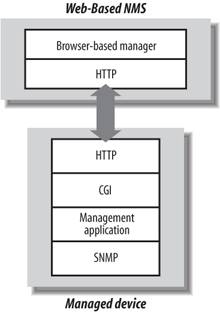Section 4.3. A Look Ahead
4.3. A Look AheadWeb-based network management entails the use of the HyperText Transfer Protocol (HTTP) and the Common Gateway Interface (CGI) to manage networked entities. It works by embedding a web server in an SNMP-compatible device, along with a CGI engine to convert SNMP-like requests (from a web-based NMS) to actual SNMP operations, and vice versa. Web servers can be embedded into such devices at very low monetary and operating cost. Figure 4-4 is a simplified diagram of the interaction between a web-based NMS and a managed device. The CGI application bridges the gap between the management application and the SNMP engine. In some cases, the management application can be a collection of Java applets that are downloaded to the web browser and executed on the web-based manager. Current versions of OpenView ship with a web-based GUI. SNMPc also has web-based capabilities. They have a Java client for the network management console and the recently released SNMPc Online, which is a web-based reporting frontend. Figure 4-4. Web-based network management Web-based network management could eliminate, or at least reduce, the need for traditional NMS software. NMS software can be expensive to purchase, set up, and maintain. Most of today's major NMS vendors support only a few popular versions of Unix and have only recently begun to support Windows, thus limiting your operating-system choices. With a web-based NMS, however, these two concerns are moot. For the most part, web browsers are free, and Unix, Windows, and Apple platforms all run the popular browsers. Web-based network management should not be viewed as a panacea, though. It is a good idea, but it will take some time for vendors to embrace this technology and move toward web integration of their existing products. There is also the issue of standardization, or the lack of it. The Web-Based Enterprise Management (WBEM) Initiative addresses this by defining a standard for web-based management. Industry leaders such as Cisco and BMC Software are among the original founders of WBEM. You can learn more about this initiative at the Distributed Management Task Force 's web page, http://www.dmtf.org/standards/wbem. Another important standard in this area is XML (eXtensible Markup Language) . XML is a markup language used for the interchange of structured data. XML makes use of DTDs (Document Type Definitions) or schemas to specify a document's structure and, in the case of schemas, to validate data. A DTD or schema is similar to an SNMP MIB. XML may be used for network management purposes in the following scenarios:
As new technology comes to the forefront, SNMP researchers, vendors, and users will embrace it whenever it makes sense. This is evidenced by the adoption of SNMPv3 as well as by the use of web technologies for tackling the problems presented by the ever-expanding scope of network management. |
EAN: 2147483647
Pages: 165